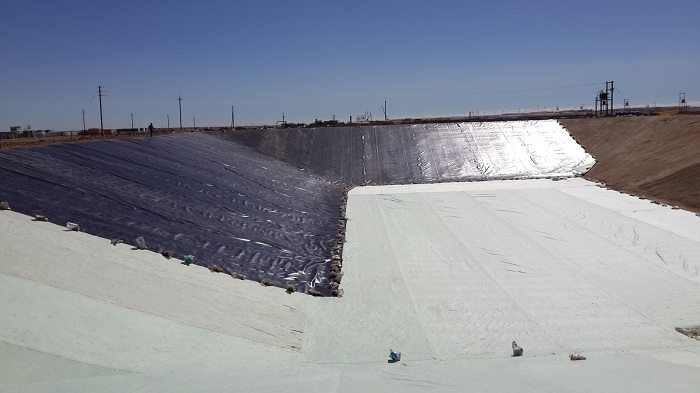Fibertex geotextiles, which are made of fibres of virgin Polypropylene (PP) material, have important functions in construction and building works – for separation, filtration, drainage, protection, and reinforcement. These materials can also act as a stress relieving waterproofing membrane when used with bitumen in road applications.
“Virgin PP offers a high level of chemical stability under a wide pH range and for this reason Fibertex geotextiles are particularly well suited for installation in areas where the textile may be in contact with alkaline conditions, for example in certain types of slimes dams and waste sites,” says Clive Hitchcock, CEO Fibertex South Africa.
“Fibertex geotextiles have many characteristics suitable for environmental protection, including resistance to most alkalis and acids, organic solvents and degreasing agents. This polymer material is UV stabilized, is non-toxic and non-staining and also resists electrolytic attacks, fungi and rot.”
Fibertex nonwoven geotextiles are well suited for use as a separation fabric to separate soils of different quality and particle size in construction works.
The excellent tensile strength and elongation of the nonwoven fabric provides the ability to resist damage, whilst offering excellent separation qualities for grade separation, as well as providing high flow rates for water to freely pass through the plane of the fabric, acting as a filter.
Soil bearing capacity is effectively increased by the prevention of intermixing of weaker subgrade materials into higher quality engineered fill materials.
These materials are also used in various filtration applications including road side drainage, revetment works for coastal protection and hydraulic construction in gabion works and railway ballast applications.
The selected dTex (thickness) of the polypropylene fibres used to make Fibertex nonwoven fabrics enables a pore size structure that retains particles as fine as silt, yet does not impede the flow of water through the fabric, due the high porosity of the fabric.
With this material, it is possible to separate two soil layers and maintain high flow rates.
Hydraulic properties enable geotextiles to be used as a drainage system to ensure ongoing drainage, with minimal pressure loss.
fibertex-geotextiles-environmental-protection…two
The unique drainage capability of a nonwoven geotextile is made possible by its transmissivity, or rather the flow of a liquid within the plane of the geotextile, rather than passing through the fabric, as is the case with the filtration feature. This can be a very useful function when draining fill behind abutments and other hard concrete structures.
Geotextiles, with a high puncture resistance, are required to be used as protection layers in the lining systems of waste disposal landfills and tunnel construction. This is added to protect waterproof membranes and other sealing materials from puncture when sharp fill material and loads are applied.
Fibertex geotextiles absorb and redistribute any point loads acting from loaded layers above, ensuring that the protected material below is not stressed to failure.
The company also manufactures flexible nonwoven paving fabrics for use in new road construction and maintenance. When used in conjunction with bitumen, the fabric acts as a water proofing layer, preventing the ingress of water into the pavement layers.
It also prevents the squeezing out of fines through cracks in the pavement surface and forms what is commonly referred to as a SAMI (stress alleviating membrane interlayer).
This stress relieving fabric can also limit and absorb differential movements in road layers, preventing reflective cracking. This all simply translates to the prevention of pavement cracking, which in turn prevents the formation of potholes in roads.
Additional information
The company’s local manufacturing plant in Hammarsdale, KwaZulu-Natal, one of six Fibertex manufacturing sites worldwide, is now the largest non woven geotextiles manufacturing facility in Africa.
Expansion of the local operation, with advanced machinery and expanded warehousing facilities, means Fibertex South Africa is well positioned to meet growing demand, not only in Africa, but also from countries in Europe, Australasia and Asia.
This facility has successfully completed a rigorous audit and has been awarded the coveted CE marking – a mandatory certification for products sold within the European Economic Area (EEA).
fibertex-geotextiles-environmental-protection…three
What’s also notable, is the Hammarsdale facility is the largest plant in South Africa that manufactures geotextiles from Virgin Polypropylene (PP). Concern for the environment is critical at Fibertex and no chemical binders are used in the product or production process.
In addition to the wide range of products made from virgin PP, Fibertex also has a range of products based on recycled Polyester (rPET). No waste is produced within the plant which has to be discarded. Similarly, all products produced are 100% recyclable. Consequently, Fibertex nonwovens are not harmful to the environment.
The Fibertex geosynthetics range encompasses the complete portfolio of products required in construction and mining industries, including non woven and woven geotextiles, gabions and mattresses, drainage pipes and fittings and erosion control and cellular confinement solutions. The company also supplies soil reinforcing products, including geogrids and geocells, as well as geosynthetic clay liners as part of composite lining systems in modern landfills.
These woven and non woven geotextiles play an important role in diverse sectors, including mining, civil engineering, construction, waste and environmental fields. The company also offers solutions to automotive, filtration, furniture and flooring industries.
The company’s continued focus on quality and customer needs has led to the expansion and improvement of business operations.
Coupled with this, global support guarantees the edge on product design, impeccable manufacturing standards, cost efficiency, safety and reliability of every material.

